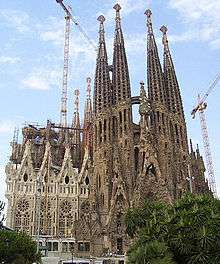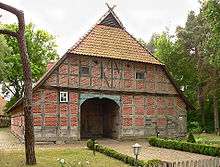Masia
.jpg)
A masia (Catalan pronunciation: [məˈzi.ə], plural masies; Aragonese: pardina, also known as mas in Catalan and Occitan (pronounced: [ˈmas])), is a type of rural construction common to the Catalan Countries, particularly in the Principality of Catalonia during the ancient Crown of Aragon[1] which have their origins in the Roman villas. They are often large but isolated structures, nearly always associated with a family farming or livestock operation.
Through the ages, the materials used to construct masies varied, often determined by their location. In mountainous areas, rough stone was often used, except for doorways, windows and arches, where stone was worked. During the Middle Ages, mud was used as mortar, though later on it was replaced by quicklime or cement. In places where stone was hard to come by, adobe was more common as a construction material.
For the most part, masies are oriented to the south. Constructions older than 16th century have an arched main entrance while those built after the 18th century usually have lintel entrances. Masies were typically constructed with wooden beams placed perpendicular to the facade and covered by tiles. In the Pyrenees and other mountainous areas, the roofing would often be made of slate.
They tended to be at least two-story buildings, with the ground floor reserved for farming tasks and even housing livestock, with the upper floor reserved for the family's living quarters. If there was a floor above that, it would often be used as a granary, or occasionally to house pigeons.
Occasionally, masies include an annexed private chapel.
In modern times, many masies have been converted into residential villas, restaurants, bed and breakfasts, or centers for rural tourism. Some house museums (i.e. Vil·la Joana, Jujol Centre - Can Negre) or have been restored and adapted for cultural uses.
Some early works of the Catalan painter Joan Miró depict his family's own masia as well as Catalan peasants.
Images
-

The Masia Can Taxonera in Arenys de Mar
-
The Rectory of Premià de Dalt, from around the 17th Century.
-

The Mas Fabregas del Bosc in l'Ametlla del Vallès
-

The Masia Mas Dorca in l'Ametlla del Vallès
-
Can Mora, in Sant Vicenç de Montalt
-
Masia de la Teijería, in Olocau del Rey, Els Ports
-

The Mas Can Pages Vell in l'Ametlla del Vallès
-
The Mas Can Masdeu, in Collserola on the outskirts of Barcelona
-

A typical masia in Xàbia
Notes
- ↑ 1. f. An estate, with a finca of either agricultural or pastoral lands, typical of those in the ancient Kingdom of Aragon.
References
- Various authors; Gran enciclopèdia catalana, Ed. Enciclopèdia catalana, Barcelona, ISBN 84-85194-81-0
- Soldevila, Ferran et alt; Història de Catalunya, Selecta-Catalònia, Barcelona, 1989 ISBN 84-7667-045-1

